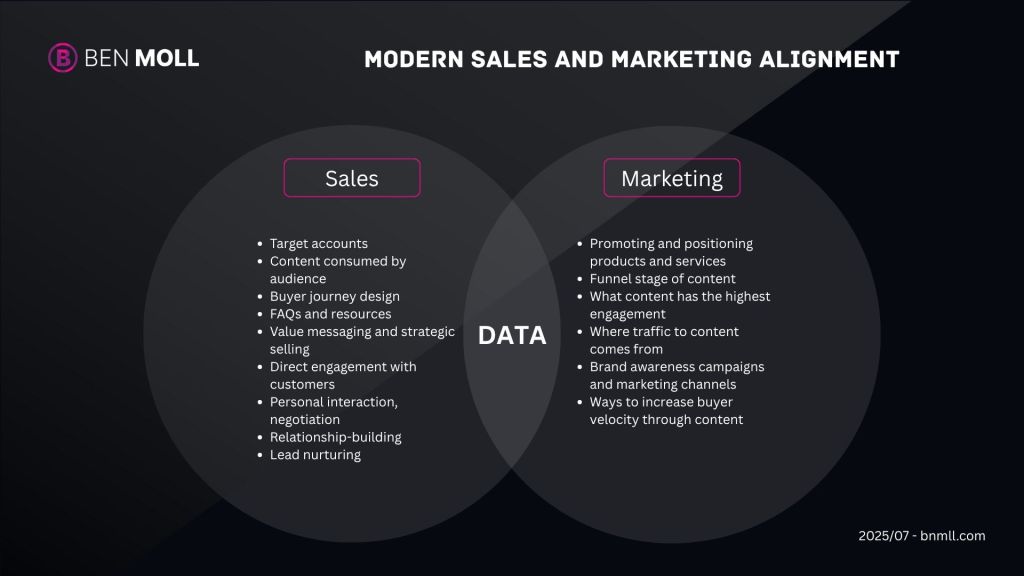A Guide to Sales and Marketing Alignment
In our hyper-competitive marketplace, achieving sales and marketing alignment is no longer a luxury. Yet, many organizations struggle to bridge the gap between their sales and marketing teams. Misaligned goals, disconnected systems, and inconsistent data often cause friction that leads to lost revenue and ineffective campaigns. The good news? Leveraging data intelligently can harmonize these two critical functions, unlocking higher conversions and sustained growth.
This in-depth article explores proven sales-marketing alignment strategies backed by data insights, real-world examples, and thoughtful processes. We’ll dive into how to integrate CRM and marketing automation, develop shared KPIs for sales and marketing, utilize lead scoring models effectively, and conduct detailed funnel metrics analysis. Whether you’re a CEO, CMO, or senior marketing director, this guide offers actionable frameworks to unify your teams and turbocharge performance.
Understanding Sales and Marketing Alignment: Why Data Matters
Sales and marketing alignment means that your marketing and sales teams operate with shared goals, unified processes, and mutual accountability—all driven by data. Disconnected teams often cause inefficiencies like redundant outreach or poor lead follow-up.
Data serves as a common language that facilitates collaboration. With accurate metrics, companies can:
- Track campaign impact on actual revenue
- Identify where leads drop off in the funnel
- Allocate resources to the highest-performing channels
- Recognize and reward team achievements transparently
According to a Harvard Business Review study, companies with well-aligned sales and marketing teams achieve 24% faster revenue growth and 27% faster profit growth.

Key Sales-Marketing Alignment Strategies Driven by Data
Successful alignment requires more than goodwill; it depends on tactical strategies informed by data. Here are essential strategies to implement:
- Establish Clear and Shared KPIs: Define metrics both teams own such as conversion rates, lead velocity, and revenue contribution.
- Develop and Refine Lead Scoring Models: Use historical data to build scoring that prioritizes best-fit, most engaged prospects.
- Integrate CRM and Marketing Automation Platforms: Ensure seamless data flow to provide real-time visibility on leads and campaigns.
- Standardize Lead Handoff Processes: Use data to optimize timing and criteria for handing leads from marketing to sales.
- Conduct Regular Funnel Metrics Analysis: Track the entire buyer journey and identify bottlenecks or leakage points.
These strategies create a feedback loop where both sales and marketing improve continuously based on objective insights rather than assumptions.
Crafting Shared KPIs for Sales and Marketing
One of the most impactful sales and marketing alignment tactics involves setting shared KPIs for sales and marketing. This fosters collective accountability and prevents silos.
Typical shared KPIs include:
- Marketing Qualified Leads (MQLs) accepted by Sales
- Sales Qualified Leads (SQLs) generated
- Lead-to-opportunity conversion rate
- Opportunity-to-close rate
- Revenue generated from marketing-sourced leads
Aligning on these metrics encourages marketing to focus on lead quality over quantity and pushes sales to provide timely feedback on lead progression.
Use dashboards that combine CRM and marketing automation data to track these KPIs in real time. For example, Salesforce and HubSpot reporting capabilities enable a single source of truth to monitor performance.
Driving Alignment Through CRM and Marketing Automation Integration
Integration between CRM and marketing automation systems is foundational. Without it, data silos form—creating inconsistent lead data, duplicate efforts, and lost opportunities.
Key benefits of effective CRM and marketing automation integration include:
- Unified contact records with updated lead statuses and activity history
- Automated lead routing based on score or behavior triggers
- Enhanced ability to personalize communications with timely data
- Comprehensive funnel visibility to both marketing and sales
- Simplified reporting on combined pipeline and campaign metrics
Leading platforms to consider: Salesforce Pardot, Marketo, HubSpot CRM, and Microsoft Dynamics Marketing. Also, third-party middleware tools like Zapier or Tray.io can bridge non-native integrations.
Utilizing Lead Scoring Models to Prioritize and Nurture Prospects
Lead scoring is pivotal for aligning sales and marketing teams on which leads to pursue. Building a data-driven lead scoring model requires:
- Analyzing historical data of converted leads to identify key attributes
- Assigning points to demographic info, engagement behavior, and buying signals
- Including negative scores for disqualifiers to filter out poor leads
- Regularly recalibrating the model with fresh data
When done right, lead scoring increases efficiency by focusing sales efforts on the highest potential opportunities and reduces wasted outreach on unqualified prospects.
For example, a B2B SaaS company might assign scores based on industry, job title, website visits, content downloads, webinar attendance, and email engagement.
Conducting Funnel Metrics Analysis for Continuous Improvement
Funnel metrics analysis provides a granular view of buyer behavior and campaign effectiveness. Key stages often evaluated include:
- Lead generation and capture rates
- Lead qualification and acceptance
- Opportunity creation and pipeline velocity
- Deal close rates and sales cycle length
By tracking these metrics over time, teams can pinpoint where prospects drop off and implement targeted interventions—whether it’s better nurture content, faster sales response, or enhanced targeting.
Invest in data visualization tools like Tableau or Power BI to build dashboards that highlight funnel leakage and conversion rates across segments and campaigns.
Maximizing your conversion funnels can only happen when you experiment with each element of customer interaction, dig deep into the analytics and then optimize the design. -Neil Patel
Insights from HubSpot emphasize that businesses with aligned marketing and sales funnels see a 36% higher customer retention rate [HubSpot].
Overcoming Common Challenges in Sales-Marketing Alignment
Despite clear benefits, organizations face obstacles in implementing aligned, data-driven sales and marketing:
- Data Silos: Fragmented systems lead to inconsistent or outdated information.
- Misaligned Goals: Sales focuses on closing deals while marketing emphasizes awareness.
- Lack of Communication: Insufficient sharing of feedback and data insights.
- Resistance to Change: Teams may be wary of new processes or technologies.
Tackling these challenges requires executive sponsorship, cross-functional workshops, and investing in technology integration. Creating joint accountability through shared KPIs also helps build trust and collaboration.
Future Trends: AI and Predictive Analytics in Sales and Marketing Alignment
Looking ahead, cutting-edge technologies like AI and predictive analytics will further revolutionize sales and marketing alignment. These innovations enable:
- Automated lead qualification and routing based on behavioral data
- Hyper-personalized messaging powered by real-time insights
- Predictive forecasting of sales pipeline health and revenue potential
- Enhanced attribution modeling to track marketing impact on closed deals
Investing in these capabilities will provide a competitive edge. Companies that operationalize AI-driven insights within a unified sales and marketing framework will outperform peers by efficiently targeting high-value prospects and accelerating sales cycles.
For marketers interested in exploring AI’s role in alignment, consider reviewing the latest frameworks at the Gartner AI Insights.
Conclusion: Embracing Data to Master Sales and Marketing Alignment
Data is the cornerstone for authentic sales and marketing alignment. Through thoughtfully implementing technology integrations, crafting shared KPIs, exploiting lead scoring models, and performing ongoing funnel metrics analysis, teams can break down silos and accelerate revenue growth.
Top 5 Takeaways:
- Set shared KPIs to drive joint accountability and clear focus.
- Integrate CRM and marketing automation tools for seamless data flow.
- Develop data-driven lead scoring to prioritize high-value prospects.
- Use funnel metrics analysis to identify and fix buyer journey bottlenecks.
- Leverage AI and predictive analytics to future-proof alignment strategies.
Ready to unlock your organization’s potential from integrated sales and marketing efforts? Request a consultation on mastering sales and marketing alignment today.






